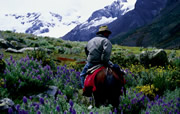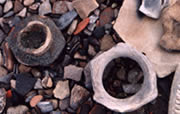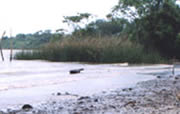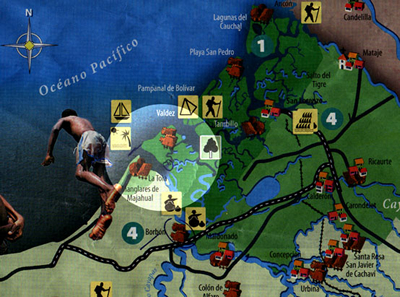|
Time Has Stopped in a Place Called
Tolita
 |
|
La Tolita's best guides are
its children.
|
Shouting at the top of his lungs, Pablo comes walking
down the road with his recently caught fish. The mangrove has been
generous to him today and now he needs to convince the people around
him that his fish are the best. No one seems to care so he sets
his goods on top of a clay pot where it drip dries, leaving its
from the salty waters of the Santiago River on the earth below.
This is a common scene in one of the little towns of the province
of Esmeraldas, La Tolita - Pampa de Oro, and it wouldn´t be
special at all were it not for the fact that clay vessel where Pablo
has place his fresh fish is over 500 years old and it's part of
Ecuador's Archaeological and Cultural Patrimony.
 |
|
The area's beaches are littered with incredible
archeological finds.
|
La Tolita Island is one of the most enigmatic places
in Ecuador. Some historians believe it was used as a ceremonial
site where people from the region came to honor the "cacique",
or high chief, with fabulous pottery and golden objects. Other experts
say this island was a gold, silver, and platinum workshop but nobody
knows for sure - the truth got lost in time, and now all we know
is that La Tolita holds an archaeological treasure.
In Ecuador, "tola" means small elevation
created by man and used as a grave. Many of these have been excavated
to be studied and the findings have shown complete sets of jewelry
and pottery that were supposed to "accompany" the dead
to the next life. Before people started raiding and pillaging, there
were close to 60 tolas on this island, but now there are only 16
left.
 |
|
Covered in the broken pieces of pottery
from generations past, Santigüero Beach is a sight to
see.
|
Today it is possible to see the remaining mounds
intact on the island and there is even one in the middle of La Tola,
a town so isolated that for many years it has been exposed to poverty
and abandonment. This situation has pressured villagers to exploit
the archaeological pieces mercilessly for many years.
Fortunately, each day more tourists have shown up with the intention
of seeing the hidden treasures that these people hold in their hands,
letting them know that they would make more money if the archaeological
objects were not destroyed.
Not only the signs of antique civilizations attract
tourists, but also the incredible nature of this area, which holds
the highest concentration of mangrove trees in the world and is
home to an uncountable number of bird species.
 |
La Tolita is located to the north of the
province of Esmeraldas, 120 km from the city of the same
name.
|
An amazing 20-minute boat ride is needed to reach
the island. Right after this unbelievable experience comes the weirdest
feeling when one has to land on Santigüero Beach, where millions
of pre-Columbian pieces of clay show up in the sand. It would seem
like the perfect place to pitch a tent and relax, but all the clay
shards that litter the beach do not leave the visitor with enough
space to place his foot much less a tent.
The experience gets even better when an open grave comes into view
or when a native child shows up playing with a doll, an original
remnant of an ancestral culture. A million pieces of pots and bottles,
remainders from ceremonial masks, thousands of fish graters, and
maybe even gold if we are lucky, together with the warmth and affection
of it's people and the beautiful landscape which surrounds the village,
make La Tolita the perfect destination for travelers who seek an
unexplored paradise, especially for those who want to become true
archaeologists, at least for a day.
|

